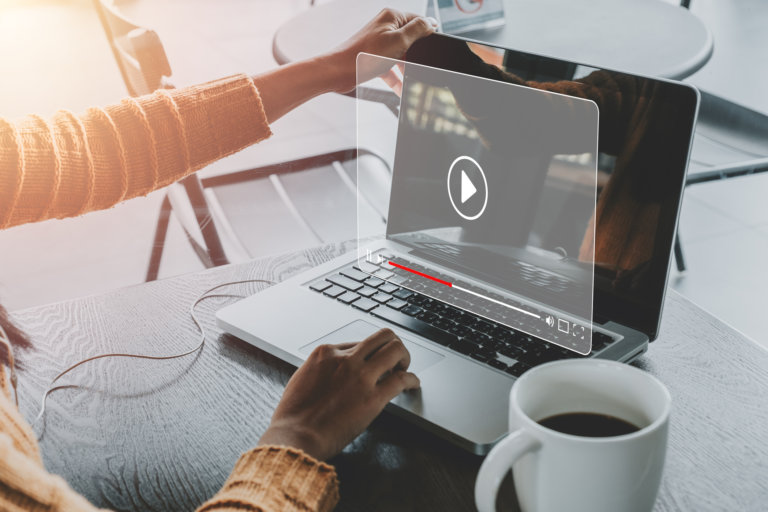Videos are powerful—but cameras can fluster even the most confident legal professional. Don’t let your fear stop you from exploiting this potent communication tool! Before you hit record, try these basic tips to get your body and mind ready to make great content.
If you have a good ring light, a compelling topic, and a laptop or smartphone, you can shoot pretty great amateur videos right from your office. Though there is certainly a place for high-quality professional videos, videos don’t need to be professionally produced to be effective. Share these videos on social media or include them in an email to contacts.
Here are five tips to help you create better videos, whether you’re in front of a professional camera crew or just in front of your iPhone and tripod.
1 – Don’t stress about memorizing
Take a deep breath. You’re not a politician addressing the nation on live TV with a monumental policy change. You’re not facing a judge in a courtroom with a well-rehearsed statement. You’re just a lawyer, standing in front of a camera, asking your audience to spend some time with you.
In most cases, memorization is unnecessary for this type of video content. Memorization can make you feel pressured. It can also make you sound less natural.
Instead of memorizing, create an outline of the most important points.
Speak to the outline rather than trying to recall your script word-for-word. You’re the expert, no script needed. Remember, you can always refer to your notes and edit out any moments where you glance down.
2 – Posture matters
It’s normal to feel a bit odd physically when in front of a camera—but this odd feeling usually manifests in a posture that looks unnatural.
The right posture can make you feel more confident and look more confident.
Many people either slouch too much or sit up too straight. Aim for a posture that is comfortable, authoritative, and relaxed. Think about your natural body position when speaking to a close friend from across the lunch table versus sitting on the exam table at the doctor’s office.
Practice physically shaking off any nerves beforehand and then sit down like you normally would. If you’re having trouble figuring out whether your posture is unnatural, you can always ask your colleagues for their feedback.
3 – Try an interview-style video
Many people prefer an interview setting, where an off-camera interviewer asks questions.
Interview-style videos can produce more natural conversation. Then, you can easily cut out the other person’s audio to create a video that appears as if you were completely alone.
To do an interview-style video, give someone else a list of the questions or topics you want to cover. Point the camera at yourself and place the interviewer beside the camera.
In your replies, restate the question in your response so it can be used as a standalone soundbite. If you are asked “Why do you love being an attorney?” you should say “I love being an attorney because I get to help people in our community” rather than “Because I get to help people in our community.”
4 – Stop if there’s a mistake—then fix it!
Unlike live television or speaking at an event, the benefit of recording videos is that you can stop at any time. There’s no need to power through if you mess up or stumble over your words. Editing is awesome. Didn’t like something you said? Try it several times and pick the best one.
Ask for a cut or stop completely if you make a mistake. Compose yourself and then go back and say it again.
Remember, you should stop speaking and pause for at least five seconds if you make a mistake. Clean stops and starts will make it much easier to edit your final video. Otherwise, you run the risk of overlapping audio. If you plan to repurpose any of this content into a podcast, TikTok, or other marketing content, clear audio is essential.
5 – Practice and watch your video back
Practice is a great way to confront camera shyness. Most people get nervous the minute the record button is hit, even if it is their 100th video!
The best way to overcome camera shyness is to get used to talking on camera—and then watch the footage back.
So get rolling, even when you don’t need a finished product. Look at yourself as an observer would. Does the person on camera have any weird quirks? Do they say “umm” a lot or do they look away from the camera after each thought?
On an intellectual level, practicing allows you to identify issues that make for a less desirable deliverable. On a physical and emotional level, practicing helps you get accustomed to the sensation of being on camera.
Review and next steps
We truly believe that anyone can get better at speaking to a camera. With practice, posture, and clever strategies like using an outline and an interviewer, you can start creating great videos from your office.
Videos can be a dynamic part of any content strategy, whether or not you choose to be in front of the camera. Before you get started, consult with the experts at Omnizant for a seamless and effective video marketing plan.

